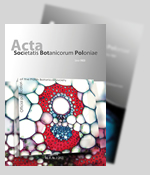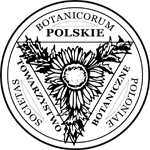Weed vegetation of arable land in Slovakia: diversity and species composition
Abstract
Keywords
Full Text:
PDFReferences
Holzner W, Immonen R. Europe: an overview. In: Holzner W, Numata N, editors. Biology and ecology of weeds. The Hague: Dr. W. Junk Publishers; 1982. p. 203–226. https://doi.org/10.1007/978-94-017-0916-3_19
Holzner W. Weed species and weed communities. Vegetatio. 1978;38:13–20. https://doi.org/10.1007/BF00141295
Sádlo J, Chytrý M, Pyšek P. Regional species pools of vascular plants in habitats of the Czech Republic. Preslia. 2007;79:303–321.
Pyšek P, Jarošík V, Chytrý M, Kropáč Z, Tichý L, Wild J. Alien plants in temperate weed communities: prehistoric and recent invaders occupy different habitats. Ecology. 2005;86:772–785. https://doi.org/10.1890/04-0012
Pyšek P, Sádlo J, Mandák B. Catalogue of alien plants of the Czech Republic. Preslia. 2002;74:97–186.
Šilc U, Lososová Z, Vrbničanin S. Weeds shift from generalist to specialist: narrowing of ecological niches along a north-south gradient. Preslia. 2014;86:35–46.
Pinke G, Pál R. Phytosociological and conservational study of the arable weed communities in western Hungary. Plant Biosyst. 2008;142:491–508. https://doi.org/10.1080/11263500802410843
Pinke G, Király G, Barina Z, Mesterházy A, Balogh L, Csiky J, et al. Assessment of endangered synanthropic plants of Hungary with special attention to arable weeds. Plant Biosyst. 2011;145:426–435. https://doi.org/10.1080/11263504.2011.563534
Kolářová M, Tyšer L, Soukup J. Impact of site conditions and farming practices on the occurrence of rare and endangered weeds on arable land in the Czech Republic. Weed Res. 2013;53:489–498. https://doi.org/10.1111/wre.12045
Lososová Z, Cimalová Š. Effects of different cultivation types on native and alien weed species richness and diversity in Moravia (Czech Republic). Basic Appl Ecol. 2009;10:456–465. https://doi.org/10.1016/j.baae.2008.11.001
Lososová Z. Estimating past distribution of vanishing weed vegetation in South Moravia. Preslia. 2003;75:71–79.
Baessler C, Klotz S. Effects of changes in agricultural land-use on landscape structure and arable weed vegetation over the last 50 years. Agric Ecosyst Environ. 2006;115:43–50. https://doi.org/10.1016/j.agee.2005.12.007
Lososová Z, Simonová D. Changes during the 20th century in species composition of synanthropic vegetation in Moravia (Czech Republic). Preslia. 2008;80:291–305.
Marshall EJP, Brown VK, Boatman ND, Lutman PJW, Squire GR, Ward LK. The role of weeds in supporting biological diversity within crop fields. Weed Res. 2003;43:77–89. https://doi.org/10.1046/j.1365-3180.2003.00326.x
Gibson RH, Nelson IL, Hopkins GW, Hamlett BJ, Memmott J. Pollinator webs, plant communities and the conservation of rare plants: arable weeds as a case study. J Appl Ecol. 2006;43:246–257. https://doi.org/10.1111/j.1365-2664.2006.01130.x
Andreasen C, Stryhn H. Increasing weed flora in Danish arable fields and its importance for biodiversity. Weed Res. 2008;48:1–9. https://doi.org/10.1111/j.1365-3180.2008.00603.x
Štatistický úrad Slovenskej republiky. Lesné hospodárstvo v Slovenskej republike za roky 2005–2009 [Internet]. 2010 [cited 2019 Nov 20]. Available from: https://slovak.statistics.sk:443/wps/portal?urile=wcm:path:/obsah-sk-pub/publikacie/
archivpublikacii/6aa8b8d0-155f-4302-946d-a6dd09fe8f5b
Májeková J, Zaliberová M. Phytosociological study of arable weed communities in Slovakia. Tuexenia. 2014;34:271–303.
Jarolímek I, Zaliberová M, Mucina L, Mochnacký S. Rastlinné spoločenstvá Slovenska 2. Synantropná vegetácia. Bratislava: Veda; 1997.
Mochnacký S. Syntaxonomy of segetal communities of Slovakia. Thaiszia. 1999;9(2000):149–204.
Lososová Z, Chytrý M, Cimalová Š, Kropáč Z, Otýpková Z, Pyšek P, et al. Weed vegetation of arable land in Central Europe: gradients of diversity and species composition. J Veg Sci. 2004;15:415–422. https://doi.org/10.1111/j.1654-1103.2004.tb02279.x
Pyšek P, Jarošík V, Kropáč Z, Chytrý M, Wild J, Tichý L. Effect of abiotic factors on species richness and cover in Central European weed communities. Agric Ecosyst Environ. 2005;109:1–8. https://doi.org/10.1016/j.agee.2005.02.018
Fried G, Norton LR, Reboud X. Environmental and management factors determining weed species composition and diversity in France. Agric Ecosyst Environ. 2008;128:68–76. https://doi.org/10.1016/j.agee.2008.05.003
Šilc U. Diversity of weed vegetation on arable land in Slovenia. Journal of Plant Diseases and Protection. 2008;21(special issue):349–354.
Šilc U, Vrbničanin S, Božić D, Čarni A, Dajić Stevanović Z. Weed vegetation in the north-western Balkans: diversity and species composition. Weed Res. 2009;49:602–612. https://doi.org/10.1111/j.1365-3180.2009.00726.x
Kolářová M, Tyšer L, Soukup J. Diversity of current weed vegetation on arable land in selected areas of the Czech Republic. Plant Soil Environ. 2013;59:208–213. https://doi.org/10.17221/783/2012-PSE
Braun-Blanquet J. Pflanzensoziologie. Grundzüge der Vegetationskunde. 3. Wien: Springer; 1964. https://doi.org/10.1007/978-3-7091-8110-2
Westhoff V, van der Maarel E. The Braun-Blanquet approach. In: Whittaker RH, editor. Classification of plant communities. The Hague: Dr. W. Junk; 1978. p. 287–399. https://doi.org/10.1007/978-94-009-9183-5_9
Barkman JJ, Doing H, Segal S. Kritische Bemerkungen und Vorschläge zur quantitativen Vegetationsanalyse. Acta Botanica Neerlandica. 1964;13:394–419. https://doi.org/10.1111/j.1438-8677.1964.tb00164.x
Klotz S, Kühn I, Durka W, editors. BIOLFLOR – Eine Datenbank mit biologisch-ökologischen Merkmalen zur Flora von Deutschland. Bonn: Bundesamt für Naturschutz; 2002. (Schriftenreihe für Vegetationskunde; vol 38).
Dostál J, Červenka M. Veľký kľúč na určovanie vyšších rastlín I., II. Bratislava: Slovenské pedagogické nakladateľstvo; 1991, 1992.
Marhold K. Ferns and flowering plants. In: Marhold K, Hindák F, editors. Checklist of non-vascular and vascular plants of Slovakia. Bratislava: Veda; 1998. p. 333–687.
Eliáš P Jr, Dítě D, Kliment J, Hrivnák R, Feráková V. Red list of ferns and flowering plants of Slovakia, 5th ed. Biologia. 2015;70:218–228. https://doi.org/10.1515/biolog-2015-0018
Medvecká J, Kliment J, Májeková J, Halada Ľ, Zaliberová M, Gojdičová E, et al. Inventory of the alien flora of Slovakia. Preslia. 2012;84:257–309.
Futák J. Činitele pôsobiace na rozšírenie rastlín. In: Lukniš M, editor. Slovensko. Príroda. Bratislava: Obzor; 1972. p. 408–412.
Lapin M, Faško P, Melo M, Šťastný P, Tomlain J. Klimatické oblasti. In: Miklós L, editor. Atlas krajiny Slovenskej republiky. Bratislava: Ministerstvo životného prostredia, Slovenská agentúra životného prostredia; 2002. p. 95.
Futák J. Fytogeografické členenie. In: Mazúr E, editor. Atlas Slovenskej socialistickej republiky. Bratislava: Slovenská akadémia vied, Slovenský úrad geodézie a kartografie; 1980. p. 88.
Ter Braak CJF, Šmilauer P. CANOCO reference manual and CanoDraw for Windows user’s guide. Software for canonical community ordination (version 4.5). Wageningen: Biometris; 2002.
Chytrý M, Tichý L, Dřevojan P, Sádlo J, Zelený D. Ellenberg-type indicator values for the Czech flora. Preslia. 2018;90:83–103. https://doi.org/10.23855/preslia.2018.083
Hill MO. Diversity and evenness: a unifying notation and its consequences. Ecology. 1973;54:427–432. https://doi.org/10.2307/1934352
Tichý L. JUICE, software for vegetation classification. J Veg Sci. 2002;13:451–453. https://doi.org/10.1111/j.1654-1103.2002.tb02069.x
Vyhláška č. 158/2014 Ministerstva životného prostredia Slovenskej republiky, ktorou sa mení a dopĺňa vyhláška Ministerstva životného prostredia Slovenskej republiky č. 24/2003 Z. z., ktorou sa vykonáva zákon č. 543/2002 Z. z. o ochrane prírody a krajiny v znení neskorších predpisov.
Glemnitz M, Radics L, Hoffmann J, Czimber G. Weed species richness and species composition of different arable field types – a comparative analysis along a climate gradient from South to North Europe. Journal of Plant Diseases and Protection. 2006;20:577–586.
Chytrý M, Pyšek P, Tichý L, Knollová I, Danihelka J. Invasions by alien plants in the Czech Republic: a quantitative assessment across habitats. Preslia. 2005;77:339–354.
Medvecká J, Jarolímek I, Senko D, Svitok M. Fifty years of plant invasion dynamics in Slovakia along a 2,500 m altitudinal gradient. Biol Invasions. 2014;16:1627–1638. https://doi.org/10.1007/s10530-013-0596-7
Lososová Z, Chytrý M, Kühn I, Hájek O, Horáková V, Pyšek P, et al. Patterns of plant traits in annual vegetation of man-made habitats in Central Europe. Perspect Plant Ecol Evol Syst. 2006;8:69–81. https://doi.org/10.1016/j.ppees.2006.07.001
Holzner W, Hayashi I, Glauninger J. Reproductive strategy of annual agrestals. In: Holzner W, Numata N, editors. Biology and ecology of weeds. The Hague: Dr. W. Junk Publishers; 1982. p. 111–121. https://doi.org/10.1007/978-94-017-0916-3_10
Lososová Z, Chytrý M, Kühn I. Plant attributes determining the regional abundance of weeds on Central European arable land. J Biogeogr. 2008;35:177–187.
Pinke G, Pál R. Floristic composition and conservation value of the stubble-field weed community, dominated by Stachys annua in western Hungary. Biologia. 2009;64:279–291. https://doi.org/10.2478/s11756-009-0035-5
Hyvönen T, Jalli H. Alien species in the Finnish weed flora. Agricultural and Food Science. 2011;20:86–95. https://doi.org/10.2137/145960611795163079
Barreda VD, Palazzesi L, Tellería MC, Olivero EB, Raine JI, Forest F. Early evolution of the angiosperm clade Asteraceae in the Cretaceous of Antarctica. Proc Natl Acad Sci USA. 2015;112(35):10989–10994. https://doi.org/10.1073/pnas.1423653112
Pyšek P. Compositae as invaders: better than the others? Preslia. 1997;69:9–22.
Pyšek P, Pergl J, Essl F, Lenzner B, Dawson W, Kreft H, et al. Naturalized alien flora of the world: species diversity, taxonomic and phylogenetic patterns, geographic distribution and global hotspots of plant invasion. Preslia. 2017;89:203–274. https://doi.org/10.23855/preslia.2017.203
Rendeková A, Mičieta K, Hrabovský M, Eliašová M, Miškovic J. Effects of invasive plant species on species diversity: implications on ruderal vegetation in Bratislava City, Slovakia, Central Europe. Acta Soc Bot Pol. 2019;88(2):3621. https://doi.org/10.5586/asbp.3621
Pashkevych N, Burda R. Distribution of alien species from Poaceae and Asteraceae families in the protected areas of Ukrainian forest-steppe. Thaiszia. 2017;27(1):29–39.
D’Amato G, Cecchi L, Bonini S, Nunes C, Annesi-Maesano I, Behrendt H, et al. Allergenic pollen and pollen allergy in Europe. Allergy. 2007;62:976–990. https://doi.org/10.1111/j.1398-9995.2007.01393.x
Pinke G, Karácsony P, Czúcz B, Botta-Dukát Z. Environmental and land-use variables determining the abundance of Ambrosia artemisiifolia in arable fields in Hungary. Preslia. 2011;83:219–235.
Hrabovský M, Ščevková J, Mičieta K, Lafférsová J, Dušička J. Expansion and aerobiology of Ambrosia artemisiifolia L. in Slovakia. Ann Agric Environ Med. 2016;23(1):64–70. https://doi.org/10.5604/12321966.1196854
Hrabovský M, Mičieta K. New findings of the common ragweed (Ambrosia artemisiifolia) in Slovakia in the year 2017. Acta Botanica Universitatis Comenianae. 2018;53:25–27.
Kolářová M, Tyšer L, Soukup J. Weed vegetation of arable land in the Czech Republic: environmental a management factors determining weed species composition. Biologia. 2014;69:443–448. https://doi.org/10.2478/s11756-014-0331-6
Andreasen C, Stryhn H, Streibig JC. Decline of the flora in Danish arable fields. J Appl Ecol. 1996;33:619–626. https://doi.org/10.2307/2404990
Glemnitz M, Czimber G, Radics L, Hoffmann J. Weed flora composition along a north-south climate gradient in Europe. Acta Agronomica Óváriensis. 2000;42:155–169.
Albrecht H. Suitability of arable weeds as indicator organisms to evaluate species conservation effects of management in agricultural ecosystems. Agric Ecosyst Environ. 2003;98:201–211. https://doi.org/10.1016/S0167-8809(03)00081-1
Türe C, Böcük H. Investigation of threatened arable weeds and their conservation status in Turkey. Weed Res. 2008;48:289–296. https://doi.org/10.1111/j.1365-3180.2008.00630.x
Hyvönen T, Salonen J. Weed species diversity and community composition in cropping practices at two intensity levels – a six-year experiment. Plant Ecol. 2002;154:73–81. https://doi.org/10.1023/A:1015580722191
Pinke G, Pál R, Botta-Dukát Z, Chytrý M. Weed vegetation and its conservation value in three management systems of Hungarian winter cereals on base-rich soils. Weed Res. 2009;49:544–551. https://doi.org/10.1111/j.1365-3180.2009.00730.x
Krippelová T, Mucina L. Charakteristika vyšších syntaxónov triedy Stellarietea mediae na Slovensku. Preslia. 1988;60:41–58.
DOI: https://doi.org/10.5586/asbp.3637
|
|
|








